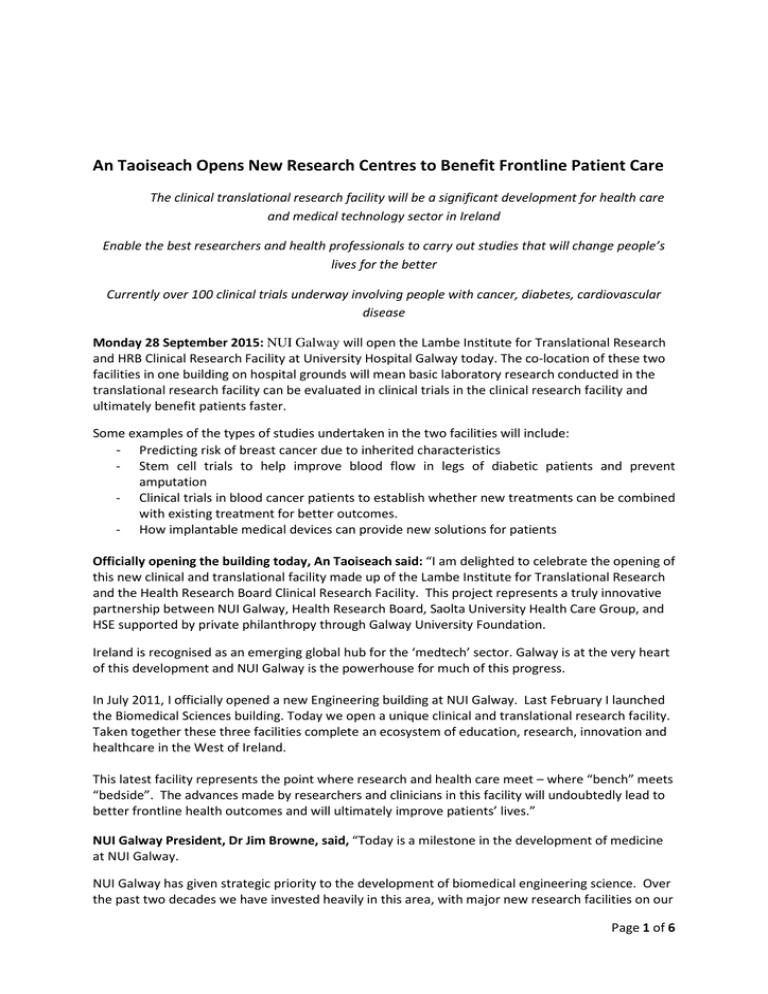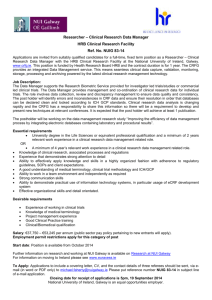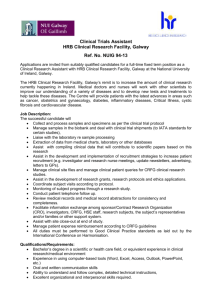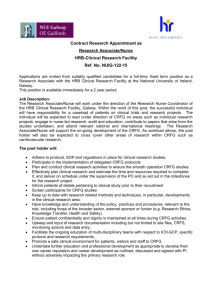An Taoiseach Opens New Research Centres to Benefit Frontline Patient...
advertisement

An Taoiseach Opens New Research Centres to Benefit Frontline Patient Care The clinical translational research facility will be a significant development for health care and medical technology sector in Ireland Enable the best researchers and health professionals to carry out studies that will change people’s lives for the better Currently over 100 clinical trials underway involving people with cancer, diabetes, cardiovascular disease Monday 28 September 2015: NUI Galway will open the Lambe Institute for Translational Research and HRB Clinical Research Facility at University Hospital Galway today. The co-location of these two facilities in one building on hospital grounds will mean basic laboratory research conducted in the translational research facility can be evaluated in clinical trials in the clinical research facility and ultimately benefit patients faster. Some examples of the types of studies undertaken in the two facilities will include: - Predicting risk of breast cancer due to inherited characteristics - Stem cell trials to help improve blood flow in legs of diabetic patients and prevent amputation - Clinical trials in blood cancer patients to establish whether new treatments can be combined with existing treatment for better outcomes. - How implantable medical devices can provide new solutions for patients Officially opening the building today, An Taoiseach said: “I am delighted to celebrate the opening of this new clinical and translational facility made up of the Lambe Institute for Translational Research and the Health Research Board Clinical Research Facility. This project represents a truly innovative partnership between NUI Galway, Health Research Board, Saolta University Health Care Group, and HSE supported by private philanthropy through Galway University Foundation. Ireland is recognised as an emerging global hub for the ‘medtech’ sector. Galway is at the very heart of this development and NUI Galway is the powerhouse for much of this progress. In July 2011, I officially opened a new Engineering building at NUI Galway. Last February I launched the Biomedical Sciences building. Today we open a unique clinical and translational research facility. Taken together these three facilities complete an ecosystem of education, research, innovation and healthcare in the West of Ireland. This latest facility represents the point where research and health care meet – where “bench” meets “bedside”. The advances made by researchers and clinicians in this facility will undoubtedly lead to better frontline health outcomes and will ultimately improve patients’ lives.” NUI Galway President, Dr Jim Browne, said, “Today is a milestone in the development of medicine at NUI Galway. NUI Galway has given strategic priority to the development of biomedical engineering science. Over the past two decades we have invested heavily in this area, with major new research facilities on our Page 1 of 6 campus. Our researchers advance scientific knowledge to address health challenges. Here in this building that scientific knowledge is being developed into novel treatments, which are then carefully applied in the clinical setting and tested in clinical trials led by NUI Galway.” Dr Graham Love, Chief Executive of the Health Research Board highlights, “The HRB Clinical Research Facility is not just a building - it is a game changer. Turning health research discoveries into real benefits for people’s health and patient care doesn’t happen by itself. This HRB facility will enable the best researchers and health professionals to carry out studies that will change people’s lives for the better. The HRB CRF will provide a safe place for patients to take part in clinical trials and access the latest treatments. It will be a centre of learning for young researchers and health professionals– so we are investing in our future. And it will also create opportunities for partnership between the health system, academia and industry that we know will support health system innovation and economic development.” Commenting, Maurice Power, CEO, Saolta University Health Care Group said, “This exciting new facility brings together leading-edge medical research directly to the bedside of patients at University Hospital Galway and the wider Hospital Group. For our patients, the facility will provide inpatient and outpatient beds, a minor operations room, endoscopy, endocrine and cardiorespiratory suites, a phlebotomy room and a biometrics unit. As well as its primary function in benefiting our patients it will also allow our Hospital Group attract and retain the highest calibre of medical professionals." Philanthropy has played a central role in this development. Galway University Foundation acknowledged the support of philanthropic donors, in particular, Dr Ronan and Ann Lambe, the 50 plus member of the Corrib Medical Network, Bank of Ireland and the National Breast Cancer Research Institute. Speaking at the launch Dr Ronan Lambe, said: “It is a great privilege for my wife and I to be associated with such a state of the art facility which will enhance the reputation of NUI Galway as a centre of excellence for Bio Medical Research.” The proximity of the University to UHG will enable direct patient access and collaborative trial input from the hospital Oncology/Haematology Clinical Trials Unit. The CRF will ensure that patients in the West and North West of Ireland have access to a number of new cancer therapies that would otherwise not have been available to them. Clinical trials are active in the treatment of melanoma, multiple myeloma, mantel cell lymphoma, breast, prostate, lung, gastrointestinal and gynaecological cancers. Some Examples of trials that are underway at the two facilities Case Study 1 – Predicting risk of breast cancer due to inherited characteristics The incidence of breast cancer is increasing and the role genetics play is not yet fully understood for the majority of women. We calculate that less than 10% of women with a strong family history have an abnormality in the BRCA1 or BRCA 2 genes which are known to be associated with a risk of developing breast cancer. According to Professor Michael Kerin, Interim Director of the Lambe Institute for Translational Research, “In the West of Ireland we have a very high incidence of breast cancer and examining the genes that cause this cancer is a key research priority and has contributed to multiple international studies, Page 2 of 6 including one which identified 74 new genetic changes associated with breast cancer. The HRBClinical Research Facility will allow new trials to be developed around these genetic targets.” Case study 2 Preventing amputation in patients with diabetes mellitus Patients with Diabetes Mellitus can often experience limited blood flow to the leg. Many patients present with gangrene, pain at rest or ulceration in the leg. While bypass of the obstruction is possible in some patients amputation may be required for one in every three patients with this complication. In fact an amputation occurs every 30 seconds somewhere in the world due to diabetes mellitus and thus new treatments are urgently required. A new study, which will take place across the HRB Clinical Research Facility, the Lambe Institute for Translational Research and University Hospital Galway will take stem cells isolated from patients’ bone marrow, grow them in a specially designed laboratory at NUI Galway and then inject them into the leg in the dedicated clinical research space. This research is a first-in-person study which aims to assess the safety and feasibility of this approach and is funded by the Health Research Board and Science Foundation Ireland. According to lead researcher, Professor Tim O Brien, Dean, College of Medicine, Nursing and Health Sciences, NUI Galway and Consultant Endocrinologist at University Hospital Galway, “The aim is to see if injections of stem cells along the leg will improve blood flow and prevent the need for amputation in these patients. This first-in-person study is designed to assess the safety and feasibility of this approach and if this is demonstrated larger studies will be required to assess efficacy. Having a dedicated laboratory provided by the Lambe Institute in close proximity to the HRB Clinical Research Facility on hospital grounds transforms our ability to do this research and provide our patients with early access to trials in a safe environment. The provision of the new facility along with recent capital developments in Galway including the Biomedical Science Research Building, the Centre for Cell Manufacturing Ireland and the Galway Blood and Tissue Establishment provides the complete infrastructure to perform studies of stem cell therapy in Ireland.” Case study 3 Tackling blood cancer Multiple myeloma is the second most common blood cancer and it has a particularly high incidence in Ireland. It is important to look for new therapies to treat people who relapse or are unresponsive to existing treatment. Another clinical trial which will take place across these two new facilities will test the efficacy of a new drug in combination with existing treatments to see if it improves outcomes for these patients. Professor Michael O’Dwyer, HRB Clinician Scientist at NUI Galway says, “Based on promising results of an initial trial, we are now moving forward to test the impact of a stronger dose of the new drug in combination with existing treatments. If this is successful, the treatment should be available to Irish patients sometime later this year. The availability of labs and clinical facilities in one place is fantastic. It creates a situation where we have the optimum facilities, skills and patients which means we are very competitive in attracting international trials. This is important because it has been shown that regardless of the outcome of trials, patients who get to participate in trials do better than those who don’t.” Page 3 of 6 Case Study 4 Prevention is better than cure – Diabetes in pregnancy Diabetes in pregnancy, known as Gestational Diabetes Mellitus (GDM) poses many risks to both mother and baby. The prevalence of GDM is 12% of all pregnancies in Ireland but varies considerably across Europe with prevalence of up to 20% reported for some populations. It is known that if women adopt and maintain a healthy lifestyle during pregnancy, they can help create optimal health outcomes for both mother and the baby they are carrying. However, there is currently little evidence that actually shows the benefits of preventing of diabetes in pregnancy. In order to build evidence in this area Professor Fidelma Dunne Consultant Endocrinologist, NUI Galway and Galway University Hospital is the Irish Principal Investigator on a new European randomised controlled trial called DALI. “This study is comparing the impact of diet, exercise, taking Vitamin D, and various combinations of these lifestyle changes, on reducing the risk of developing gestational diabetes in at-risk pregnant women. The HRB Clinical Research Facility is one of 11 centres around Europe where this EU FP7 funded study is taking place.” She continues, ‘It is essential that we increase the evidence base and highlight the importance of preventing and managing diabetes in pregnancy for mother and baby.’ According to Professor Martin O’Donnell, Director of the HRB Clinical Research Facility at NUI Galway, “In tandem with our focus on improving clinical care of patients, a clear priority for the HRB Clinical Research Facility is to improve health at a population level, through prevention of disease. At the HRB-CRFG we are conducting a range of studies that will inform optimal approaches to preventing stroke, heart attack and dementia in populations, with a focus on nutrition, blood pressure, obesity, diabetes and lifestyle behaviours.” Case Study 5 - Predicting responses to chemotherapy in breast cancer patients The era of personalised medicine means that chemotherapy is now more targeted towards specific cancer subtypes. However the prediction of response to common chemotherapeutic agents still poses a problem for clinicians. It would be beneficial to be able to predict treatment response by a simple blood test and save women, who are not getting the benefit from chemotherapy, the trauma of continued treatment and instead give them the option of an alternative and better regimen. According to Professor Michael Kerin, Interim Director of the Lambe Institute for Translational Research, "We have exciting data from trials which suggest that specific biomarkers (microRNAs) circulating in the bloodstream can predict response to treatment in breast cancer. As a result of this we may be able to select better therapies for patients. The research questions raised will be translated into new clinical trials in conjunction with the HRB-Clinical Research Facility.” If you would like more information on the work of the HRB Clinical Research Facility, please email crfg@nuigalway.ie -ENDS For more information please contact: Michelle Ní Chróinín, Press Office, NUI Galway T: 091-493361 M: 087-9025383 E:michelle.nichroinin@nuigalway.ie Page 4 of 6 Notes to editors The Lambe Institute for Translational Research Funded under the Irish Government’s Higher Education Authority Programme for Research in Third Level Institutions (PRTLI-5) award, the Lambe Institute is a fitting clinical and translational collaboration between NUI Galway, the Saolta University Health Care Group, national Health Service Executive (HSE), supported by Galway University Foundation (GUF), and its philanthropy partners. The Lambe Institute for Translational Research has encouraged interdisciplinary research programmes and collaborations with industry partners in areas of strategic importance, both regionally and nationally. The key strategic research priorities of the College of Medicine, Nursing and Health Sciences (CMNHS) are Cancer Research, Regenerative Medicine and Medical Devices. The Translational Research Facility is operated by NUI Galway and was developed with support from the Galway University Foundation (GUF) and chief donors, Dr Ronan and Mrs Ann Lambe. A significant contribution was also made by the National Breast Cancer Research Institute. The HRB Clinical Research Facility Funded primarily by the Health Research Board, the HRB Clinical Research Facility is a collaboration between Saolta University Health Care Group, HSE and NUI Galway and the HRB. This Facility will enable clinicians, the health care industry and other key partners to test innovative therapies, technologies and products and increase the speed at which scientific discoveries and innovations can be translated into better health, improved patient care and advances in health service delivery. For the past decade, the Health Research Board (HRB) has been pursuing a very deliberate and strategic approach to develop Ireland’s clinical research infrastructure to ensure new research discoveries lead to improvements in peoples’ health, patient care and health service delivery. To date the HRB has invested more than €90 million in clinical research infrastructure to ensure patients benefit from the latest scientific advances in research. A lot of this money has supported the development of three HRB Clinical Research Facilities in Dublin, Galway and Cork. Based on hospital grounds these facilities provide the necessary interface to turn research discoveries into benefits for patients and health service delivery. The HRB Clinical Research Facility in Galway is a key part of this infrastructure, representing an investment of €20 million to date. The HRB Clinical Research Facility will deliver: • • • • • • Better health and healthcare – new diagnostics, better prognosis, preventative medicines, more effective ways to deliver care Patient benefits - from participation in the latest trials in a regulated and safe environment Quality and standards – regulatory demands of a CRF and clinical trials drive improvements in safety, quality and standards Career advancement opportunities for health professionals at home in Ireland Industry opportunities– in bringing research closer to the market Economic gains – creating the infrastructure and regulatory network to attract clinical trials, pharma and medical device companies to Ireland A number of videos are available from the HRB You Tube channel that further explain how the facility works https://www.youtube.com/channel/UCbLSR-mOv2k18sZAb_zLzKA Page 5 of 6 If you would like more information on the work of the HRB Clinical Research Facility, please email crfg@nuigalway.ie Saolta University Health Care Group is comprised of University Hospital Galway, Merlin Park University Hospital, Portiuncula Hospital Ballinasloe, Roscommon Hospital, Mayo General Hospital, Sligo Regional Hospital and Letterkenny General Hospital. The Group provides health services to a population of over 800,000 people across its seven hospital sites. There are 9,258 staff working in the Group and it has a financial turnover of over €820 million. The Group’s academic partner is NUI Galway. The Health Research Board is the lead agency funding health research in Ireland. Its mission is to support research that improves people’s health, advances patient care and enhances health service delivery To date it has invested more than €90 million in clinical research infrastructures to ensure today’s health research becomes tomorrow health care. HRB is committed to investing in research that drives innovation in Ireland’s health system, provides evidence to inform health policy and practice and contributes to Ireland’s economic development. Page 6 of 6



